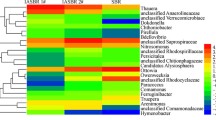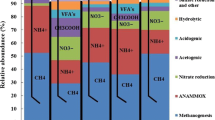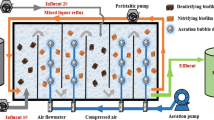Abstract
A novel combined bioreactor integrating anaerobic baffling and anaerobic filtration process was developed and operated for 210 days to treat low-strength rural wastewater. The effects of hydraulic residence time (HRT) and organic loading rate (OLR) on chemical oxygen demand (COD) removal and methane (CH4) production of the combined bioreactor were investigated. The combined bioreactor can start up successfully in 25 days and achieve enhanced performance. The COD removal rate and CH4 yield were influenced significantly by HRT and OLR. The influent COD was removed effectively through the synergistic effects of the anaerobic baffling and anaerobic filtration. The baffle zone played the main role in the degradation of the pollutants, and the filter zone mainly contributed to improve the resistance to shock loading. High-throughput sequencing technology was used to analyze the bacterial and archaeal community structure and diversity. Clostridium_sensu_stricto, Longilinea, Acetoanaerobium, Arcobacter, and Acinetobacter were found to be the dominant bacteria. While Methanothrix and Methanoregula were the dominant archaea, which were responsible for methane generation. This study not only highlights the good energy recovery and resource utilization potential of the combined bioreactor but also presents significant guidance for the application of the combined anaerobic process for low-strength rural wastewater treatment.








Similar content being viewed by others
References
Adebusoye SA, Ilori MO, Picardal FW, Amund OO (2007) Cometabolic degradation of polychlorinated biphenyls (PCBs) by axenic cultures of Ralstonia sp. strain SA-5 and Pseudomonas sp. strain SA-6 obtained from Nigerian contaminated soils. World J Microbiol Biotechnol 24(1):61–68
Almuktar SAAAN, Abed SN, Scholz M (2018) Wetlands for wastewater treatment and subsequent recycling of treated effluent: a review. Environ Sci Pollut Res 25(24):23595–23623
Amani T, Nosrati M, Mousavi SM, Elyasi S (2015) Study of microbiological and operational parameters in thermophilic syntrophic degradation of volatile fatty acids in an upflow anaerobic sludge blanket reactor. J Environ Chem Eng 3(1):507–514
APHA (2012) Standard methods for the examination of water and wastewater, twenty-second ed. American Public Health Association/American Water Works Association/Water Environment Federation, Washington
Ban Q, Li J, Zhang L, Jha AK, Nies L (2013) Linking performance with microbial community characteristics in an anaerobic baffled reactor. Appl Biochem Biotechnol 169(6):1822–1836
Beale DJ, Karpe AV, McLeod JD, Gondalia SV, Muster TH, Othman MZ, Palombo EA, Joshi D (2016) An ‘omics’ approach towards the characterisation of laboratory scale anaerobic digesters treating municipal sewage sludge. Water Res 88:346–357
Bodík I, Kratochvíl K, Herdová B, Tapia G, Gašpariková E (2002) Municipal wastewater treatment in the anaerobic-aerobic baffled filter reactor at ambient temperature. Water Sci Technol 46(8):127–135
Bodkhe S (2008) Development of an improved anaerobic filter for municipal wastewater treatment. Bioresour Technol 99(1):222–226
Bodkhe SY (2009) A modified anaerobic baffled reactor for municipal wastewater treatment. J Environ Manag 90(8):2488–2493
Chen M, Chen J, Du P (2006) An inventory analysis of rural pollution loads in China. Water Sci Technol 54(11–12):65–74
Chen R, Nie YL, Ji JY, Utashiro T, Li Q, Komori D, Li YY (2017) Submerged anaerobic membrane bioreactor (SAnMBR) performance on sewage treatment: removal efficiencies, biogas production and membrane fouling. Water Sci Technol 76(5–6):1308–1317
Chen J, Liu YS, Deng WJ, Ying GG (2019) Removal of steroid hormones and biocides from rural wastewater by an integrated constructed wetland. Sci Total Environ 660:358–365
Crone BC, Garland JL, Sorial GA, Vane LM (2016) Significance of dissolved methane in effluents of anaerobically treated low strength wastewater and potential for recovery as an energy product: a review. Water Res 104:520–531
Dereli RK, Ersahin ME, Ozgun H, Ozturk I, Jeison D, van der Zee F, van Lier JB (2012) Potentials of anaerobic membrane bioreactors to overcome treatment limitations induced by industrial wastewaters. Bioresour Technol 122:160–170
Feng HJ, Hu LF, Mahmood Q, Qiu CD, Fang CR, Shen DS (2008) Anaerobic domestic wastewater treatment with bamboo carrier anaerobic baffled reactor. Int Biodeterior Biodegrad 62(3):232–238
Feng HJ, Hu LF, Mahmood Q, Fang CR, Qiu CD, Shen DS (2009) Effects of temperature and feed strength on a carrier anaerobic baffled reactor treating dilute wastewater. Desalination 239(1–3):111–121
Feng J, Wang YL, Ji XY, Yuan DQ, Li H (2015) Performance and bioparticle growth of anaerobic baffled reactor (ABR) fed with low-strength domestic sewage. Front Env Sci Eng 9(2):352–364
Florencio L, Kato MT, Cardoso de Morais J (2001) Domestic sewage treatment in full-scale UASBB plant at Mangueira, Recife, Pernambuco. Water Sci Technol 44(4):71–77
Fouché O, Lasagna M, Danert K (2018) Groundwater under threat from diffuse contaminants: improving on-site sanitation, agriculture and water supply practices. Environ Sci Pollut Res 26(3):2023–2025
Fykse EM, Aarskaug T, Madslien EH, Dybwad M (2016) Microbial community structure in a full-scale anaerobic treatment plant during start-up and first year of operation revealed by high-throughput 16S rRNA gene amplicon sequencing. Bioresour Technol 222:380–387
Grobicki A, Stuckey DC (1991) Performance of the anaerobic baffled reactor under steady-state and shock loading conditions. Biotechnol Bioeng 27(4):344–355
Gu BJ, Fan LG, Ying ZC, Xu QS, Luo WD, Ge Y, Scott S, Chang J (2016) Socioeconomic constraints on the technological choices in rural sewage treatment. Environ Sci Pollut Res 23(20):20360–20367
Guest JS, Skerlos SJ, Barnard JL, Beck MB, Daigger GT, Hilger H, Jackson SJ, Karvazy K, Kelly L, Macpherson L, Mihelcic JR, Pramanik A, Raskin L, van Loosdrecht MCM, Yeh D, Love NG (2009) A new planning and design paradigm to achieve sustainable resource recovery from wastewater. Environ Sci Technol 43(16):6126–6130
Gui XF, Xu WC, Cao HB, Ning PG, Zhang YX, Li YP, Sheng YX (2019) A novel phenol and ammonia recovery process for coal gasification wastewater altering the bacterial community and increasing pollutants removal in anaerobic/anoxic/aerobic system. Sci Total Environ 661:203–211
Guo JH, Peng YZ, Ni BJ, Han XY, Fan L, Yuan ZG (2015) Dissecting microbial community structure and methane-producing pathways of a full-scale anaerobic reactor digesting activated sludge from wastewater treatment by metagenomic sequencing. Microb Cell Factories 14:1–11
Hahn MJ, Figueroa LA (2015) Pilot scale application of anaerobic baffled reactor for biologically enhanced primary treatment of raw municipal wastewater. Water Res 87:494–502
Ham JH, Yoon CG, Jeon JH, Kim HC (2007) Feasibility of a constructed wetland and wastewater stabilisation pond system as a sewage reclamation system for agricultural reuse in a decentralised rural area. Water Sci Technol 55(1–2):503–511
Han YP, Ma JW, Xiao BY, Huo XC, Guo XS (2019) New integrated self-refluxing rotating biological contactor for rural sewage treatment. J Clean Prod 217:324–334
Hu Y, Jing ZQ, Sudo Y, Niu QG, Du JR, Wu J, Li YY (2015) Effect of influent COD/SO42− ratios on UASB treatment of a synthetic sulfate-containing wastewater. Chemosphere 130:24–33
Kato MT, Field JA, Lettinga G (1997) The anaerobic treatment of low strength wastewaters in UASB and EGSB reactors. Water Sci Technol 36(6–7):375–382
Kobayashi HA, Stenstrom MK, Mah RA (1983) Treatment of low strength domestic wastewater using the anaerobic filter. Water Res 17:903–909
Krishna GVTG, Kumar P, Kumar P (2008) Treatment of low strength complex wastewater using an anaerobic baffled reactor (ABR). Bioresour Technol 99(17):8193–8200
Lei Z, Yang SM, Li YY, Wen W, Wang XC, Chen R (2018) Application of anaerobic membrane bioreactors to municipal wastewater treatment at ambient temperature: a review of achievements, challenges, and perspectives. Bioresour Technol 267:756–768
Li XM, Guo L, Yang Q, Zeng GM, Liao DX (2007) Removal of carbon and nutrients from low strength domestic wastewater by expanded granular sludge bed-zeolite bed filtration (EGSB-ZBF) integrated treatment concept. Process Biochem 42(8):1173–1179
Li SN, Nan J, Gao F (2016) Hydraulic characteristics and performance modeling of a modified anaerobic baffled reactor (MABR). Chem Eng J 284:85–92
Liu Z, Yin H, Dang Z, Liu Y (2013) Dissolved methane: a hurdle for anaerobic treatment of municipal wastewater. Environ Sci Technol 48(2):889–890
Ma JW, Zhao QB, Laurens LL, Jarvis EE, Nagle NJ, Chen SL, Frear CS (2015) Mechanism, kinetics and microbiology of inhibition caused by long-chain fatty acids in anaerobic digestion of algal biomass. Biotechnol Biofuels 8:141–252
Ma SJ, Ma HJ, Hu HD, Ren HQ (2019a) Effect of mixing intensity on hydrolysis and acidification of sewage sludge in two-stage anaerobic digestion: characteristics of dissolved organic matter and the key microorganisms. Water Res 148:359–367
Ma YH, Zhai YK, Zheng XG, He SB, Zhao M (2019b) Rural domestic wastewater treatment in constructed ditch wetlands: effects of influent flow ratio distribution. J Clean Prod 225:350–358
Mizuta K, Shimada M (2010) Benchmarking energy consumption in municipal wastewater treatment plants in Japan. Water Sci Technol 62(10):2256–2262
Mortezaei Y, Amani T, Elyasi S (2018) High-rate anaerobic digestion of yogurt wastewater in a hybrid EGSB and fixed-bed reactor: optimizing through response surface methodology. Process Saf Environ 113:255–263
Nasr FA, Doma HS, Nassar HF (2008) Treatment of domestic wastewater using an anaerobic baffled reactor followed by a duckweed pond for agricultural purposes. Environmentalist 29(3):270–279
Renuka R, Mohan SM, Sowmiya B, Raj SA (2016) Performance evaluation of panelled anaerobic baffle-cum-filter reactor in treating municipal wastewater. Ecol Eng 97:1–12
Reynaud N, Buckley CA (2015) The anaerobic baffled reactor (ABR) treating communal wastewater under mesophilic conditions: a review. Water Sci Technol 73(3):463–478
Rotaru A-E, Shrestha PM, Liu F, Shrestha M, Shrestha D, Embree M, Zengler K, Wardman C, Nevin KP, Lovley DR (2014) A new model for electron flow during anaerobic digestion: direct interspecies electron transfer to Methanosaeta for the reduction of carbon dioxide to methane. Energy Environ Sci 7(1):408–415
Sayedin F, Kermanshahi-pour A, He QS (2019) Evaluating the potential of a novel anaerobic baffled reactor for anaerobic digestion of thin stillage: effect of organic loading rate, hydraulic retention time and recycle ratio. Renew Energy 135:975–983
Shi YH, Huang JH, Zeng GM, Gu YL, Chen YN, Hu Y, Tang B, Zhou JX, Yang Y, Shi LX (2017) Exploiting extracellular polymeric substances (EPS) controlling strategies for performance enhancement of biological wastewater treatments: an overview. Chemosphere 180:396–411
Shoener BD, Bradley IM, Cusick RD, Guest JS (2014) Energy positive domestic wastewater treatment: the roles of anaerobic and phototrophic technologies. Environ Sci Proc Impacts 16(6):1204–1222
Shu DT, He YL, Yue H, Wang QY (2015) Microbial structures and community functions of anaerobic sludge in six full-scale wastewater treatment plants as revealed by 454 high-throughput pyrosequencing. Bioresour Technol 186:163–172
Song GQ, Xi HB, Zhou YX, Fu LY, Xing X, Wu CY (2017) Influence of organic load rate (OLR) on the hydrolytic acidification of 2-butenal manufacture wastewater and analysis of bacterial community structure. Bioresour Technol 243:502–511
Song P, Huang GH, An CJ, Shen J, Zhang P, Chen XJ, Shen J, Yao Y, Zheng RB, Sun CX (2018) Treatment of rural domestic wastewater using multi-soil-layering systems: performance evaluation, factorial analysis and numerical modeling. Sci Total Environ 644:536–546
Song P, Huang GH, An CJ, Zhang P, Chen XJ, Ren S (2019) Performance analysis and life cycle greenhouse gas emission assessment of an integrated gravitational-flow wastewater treatment system for rural areas. Environ Sci Pollut Res 26(25):25883–25897
Souza CL, Chernicharo CA, Aquino SF (2011) Quantification of dissolved methane in UASB reactors treating domestic wastewater under different operating conditions. Water Sci Technol 64(11):2259–2264
Stazi V, Tomei MC (2018) Enhancing anaerobic treatment of domestic wastewater: state of the art, innovative technologies and future perspectives. Sci Total Environ 635:78–91
Stefanakis AI, Tsihrintzis VA (2012) Effects of loading, resting period, temperature, porous media, vegetation and aeration on performance of pilot-scale vertical flow constructed wetlands. Chem Eng J 181-182:416–430
Su CY, Deng QJ, Lu YX, Qin RH, Chen SL, Wei JW, Chen ML, Huang Z (2019) Effects of hydraulic retention time on the performance and microbial community of an anaerobic baffled reactor-bioelectricity Fenton coupling reactor for treatment of traditional Chinese medicine wastewater. Bioresour Technol 288:121508
Sundberg C, Al-Soud WA, Larsson M, Alm E, Yekta SS, Svensson BH, Sorensen SJ, Karlsson A (2013) 454 pyrosequencing analyses of bacterial and archaeal richness in 21 full-scale biogas digesters. FEMS Microbiol Ecol 85(3):612–626
Xu WC, Zhang YX, Cao HB, Sheng YX, Li HB, Li YP, Zhao H, Gui XF (2018) Metagenomic insights into the microbiota profiles and bioaugmentation mechanism of organics removal in coal gasification wastewater in an anaerobic/anoxic/oxic system by methanol. Bioresour Technol 264:106–115
Yamada T, Sekiguchi Y, Hanada S, Imachi H, Ohashi A, Harada H, Kamagata Y (2006) Anaerolinea thermolimosa sp. nov., Levilinea saccharolytica gen. nov., sp. nov. and Leptolinea tardivitalis gen. nov., sp. nov., novel filamentous anaerobes, and description of the new classes Anaerolineae classis nov. and Caldilineae classis nov. in the bacterial phylum Chloroflexi. Int J Syst Evol Microbiol 56(Pt 6):1331–1340
Yeo H, An J, Reid R, Rittmann BE, Lee HS (2015) Contribution of liquid/gas mass-transfer limitations to dissolved methane oversaturation in anaerobic treatment of dilute wastewater. Environ Sci Technol 49(17):10366–10372
Zhu G, Zou R, Jha AK, Huang X, Liu L, Liu C (2014) Recent developments and future perspectives of anaerobic baffled bioreactor for wastewater treatment and energy recovery. Crit Rev Environ Sci Technol 45(12):1243–1276
Acknowledgments
This work was financially supported by the Science and Technology Major Projects of China’s “13th Five-Year Plan” under the Water Pollution Control and Governance (2017ZX07102004-005).
Author information
Authors and Affiliations
Corresponding author
Additional information
Responsible Editor: Ta Yeong Wu
Publisher’s note
Springer Nature remains neutral with regard to jurisdictional claims in published maps and institutional affiliations.
Rights and permissions
About this article
Cite this article
Liu, J., Liu, X., Gao, L. et al. Performance and microbial community of a novel combined anaerobic bioreactor integrating anaerobic baffling and anaerobic filtration process for low-strength rural wastewater treatment. Environ Sci Pollut Res 27, 18743–18756 (2020). https://doi.org/10.1007/s11356-020-08263-9
Received:
Accepted:
Published:
Issue Date:
DOI: https://doi.org/10.1007/s11356-020-08263-9




